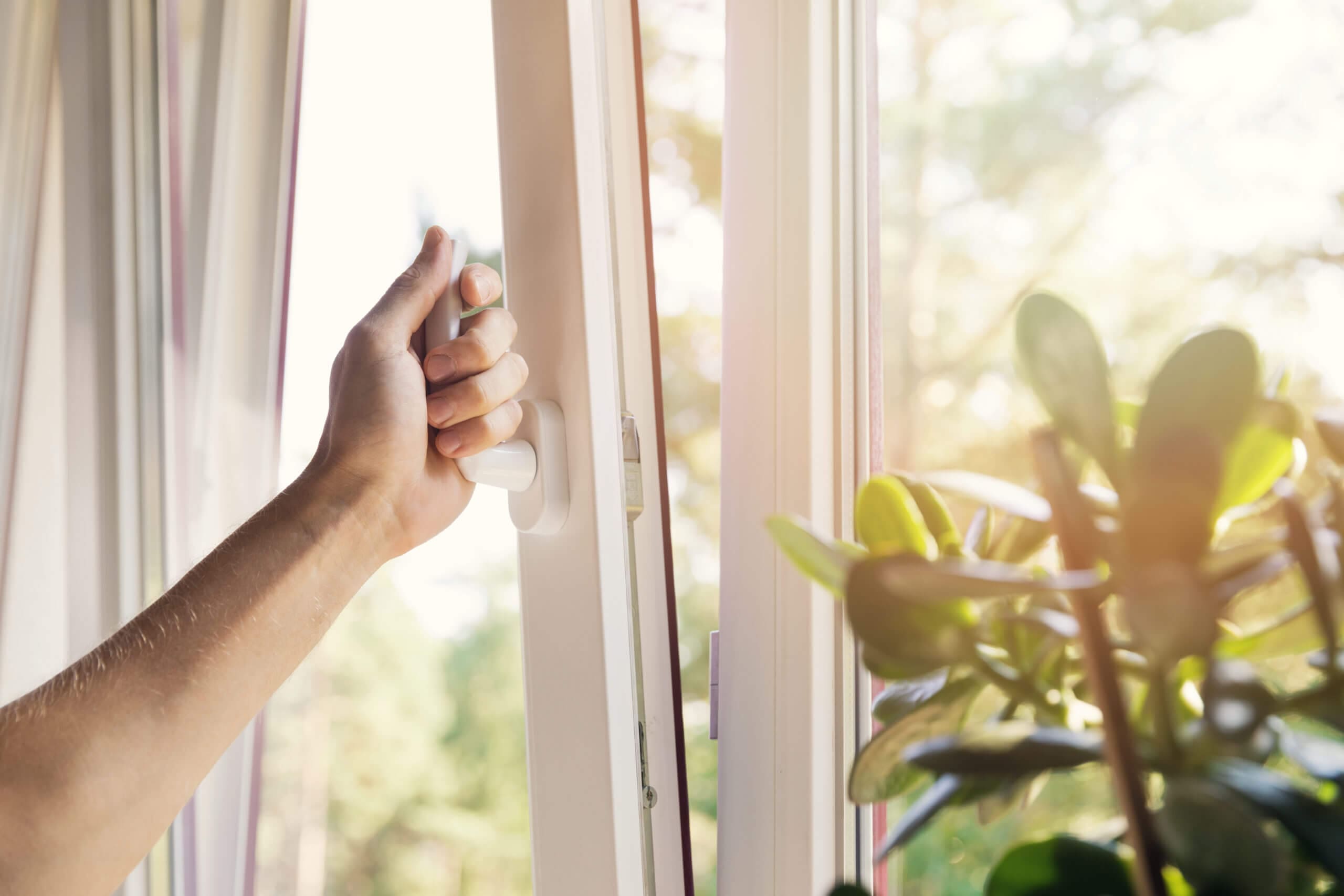Too much time indoors can be bad for your health.
Considering the average amount of time spent inside, it has significant effects. The official terms for illness caused by indoor spaces are sick building syndrome (SBS) and building-related illness (BRI). SBS means the root cause is unknown but it’s clear that the issue stems from time spent in the space. BRI is when the origin(s) of the illness are identifiable in the building.
Stale indoor air also causes a plethora of problems in homes.
All indoor space related health issues are often due to poor airflow and the specific air particles stuck circulating inside. So, what exactly is stale indoor air?
What Is Stale Indoor Air?
Stale indoor air is simply air that is either poorly circulated or not circulated in a space. Minimal, poor, or lack of air circulation means living and working in areas and consistently breathing old air.
Stale air occurs when indoor spaces lack proper ventilation, leading to:
- Decreased oxygen levels
- Increased carbon dioxide concentration
- Accumulation of indoor pollutants
- Higher humidity levels
- Build-up of odors and airborne particles
The problem with stale or old air is that it causes occupants to be further exposed to harmful particles, air toxins, and hazardous chemicals in circulation.
Air that doesn’t circulate well allows said toxins to sit in a room or space for extended periods and increases exposure.
While every space has its share of toxins that needs to be filtered or ventilated, buildup occurs if the air isn’t circulating regularly.
Fresh cleaner air is drastically important for everyone’s health and well-being and the quality of indoor spaces.
Signs of Stale Air in Your Home
If you’re experiencing any of the following symptoms, it could be a sign that the air in your home is stale:
Feeling Stuffy or Congested
One of the most common symptoms of stale air is feeling congested or experiencing nasal stuffiness. This can be particularly noticeable when spending extended periods of time indoors.
- Constantly feeling like you have a stuffy nose
- Frequent sneezing or coughing
Lingering Odors
If you notice that certain odors seem to linger in your home, even after cleaning, it could be a sign of poor air circulation. Stale air can trap odors and make them more noticeable.
- Lingering cooking smells
- Musty or stale odors
Physical Symptoms
- Headaches
- Fatigue
- Difficulty concentrating
- Dry or irritated eyes
- Respiratory issues
- Allergic reactions
Environmental Indicators
- Stuffy or heavy feeling in rooms
- Condensation on windows
- Lingering odors
- Visible dust accumulation
- Mold growth
Health Risks of Stagnant Air
According to the EPA, poor indoor air quality can lead to both short-term and long-term health issues. Exposure to stale air may:
- Trigger asthma symptoms
- Worsen allergies
- Cause respiratory infections
- Lead to sick building syndrome
- Affect cognitive performance
How Does Air Become Unhealthy?
Dust and mold are common contaminating culprits. Also, cleaning supplies, cooking and cooking methods, and hot showers are additional sources of pollutants.
Sadly, most of our daily activities contribute to polluted air. And this is in addition to other invisible indoor sources that increase pollution. These are home location, outdoor pollutants, or the building materials used.
This combination of factors means ensuring good air circulation is crucial. Gases, excess humidity, bacteria, and other pollutants never have an opportunity to leave a poorly circulated space. Then, occupants are left to inhale the polluted air far longer than they should.
Poor circulation is common in buildings as windows and doors aren’t open often enough to let proper amounts of fresh air in. It is perhaps more common in extreme temperatures or humid climates because it’s too hot or cold to leave windows open on a regular basis. This can cause a buildup of pollutants and humidity, which makes it easier for bacteria and mold to grow.
Poor circulation is also common in homes, specifically newer builds. New construction has prioritized energy efficiency and uses better construction practices. The result, however, is less natural ventilation. This unintended consequence means reduced airflow. New construction limits airflow through gaps and cracks in home foundations present in older builds.
Stale Indoor Air Symptoms

Stale air can be an unpleasant smell or make a room feel stuffy. At low levels, it’s uncomfortable but at higher concentrations, stale air becomes unhealthy for those sensitive to its effects. Breathing in high doses of this type has been linked with skin irritation, headaches, and fatigue.
People that work or live in buildings and homes with poor air circulation can notice the effects in a few ways. Those suffering from excess humidity might be prone to fatigue and worsening allergies.
Those suffering from low humidity levels due to poor circulation likely notice dry skin and eyes. In warm spaces, nausea, headaches, and nasal irritation are common.
Respiratory system irritation due to poor circulation often causes coughing and congestion. It can also worsen said symptoms.
Common Symptoms of a Stuffy Room
- Difficulty breathing
- Headaches
- Nasal congestion
- Watery or itchy eyes
- Coughing or sneezing
Not all who work or live in poorly circulated spaces experience these symptoms equally. SBS, BRI, and the aforementioned problems usually affect those with allergies and asthma more severely. However, in situations where mold or bacteria growth is severe and circulation is limited, the outcome can be dangerous for anyone.
How to Fix Stale Air in Your House
There are a variety of ways to improve the air quality in our indoor spaces. For improving poor air circulation, the answer is always ventilation.
An easy ventilation method is to open windows and/or doors whenever possible to allow fresh air in. Due to weather, temperatures, safety, and other reasons, this is not always a viable option.
The second ventilation solution is mechanical ventilation. Mechanical ventilation ensures proper air circulation and the entire home has fresh air.
A mechanical ventilation system is installed directly to the existing HVAC system, making it a low-maintenance solution.
Immediate Solutions
- Open windows daily for cross-ventilation
- Use ceiling fans to circulate air
- Install bathroom and kitchen exhaust fans
- Place portable fans strategically
- Consider air purifiers with HEPA filters
Long-term Improvements
- Install a whole-house ventilation system
- Regular HVAC maintenance
- Add air exchange systems
- Update weatherstripping and seals
- Monitor humidity levels
Prevention Tips for Maintaining Fresh Air
- Schedule regular ventilation periods
- Keep air filters clean
- Control humidity levels (30-50%)
- Remove sources of pollutants
- Use natural cleaning products
- Add indoor plants for natural air filtering
Upgrading to a whole-home ventilation system reduces and keeps toxins out of the air by providing consistent airflow. There are two types of mechanical ventilation systems: ERVs and HRVs. Energy recovery ventilation and heat recovery ventilation systems use slightly different methods, but both actively pull fresh outdoor air in and remove stale indoor air.
Make Fresh Air a Priority

The bottom line is: breathing in stale and polluted air is bad for your health. Poor circulation means harmful particles and toxins can accumulate in your spaces. Cleaning helps remove dust and pollutants, but proper circulation is the ideal long-term solution for all of your spaces. A whole-home ventilation system is the best choice to get rid of stale air and provide a healthier cleaner breathing space for all occupants.
FAQ About Stale Air
Yes, prolonged exposure to stale air can cause various health issues, including respiratory problems, headaches, and fatigue.
Air can become stale within 2-3 hours in an unventilated room, especially with occupants present.
While similar, stuffy air typically refers to the immediate sensation of poor ventilation, while stale air indicates a longer-term air quality issue.




